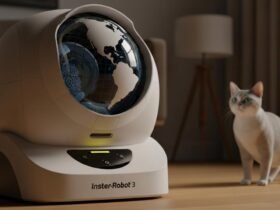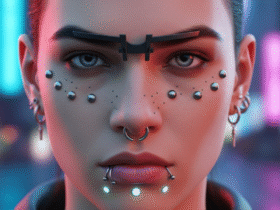There really is something cool about stepping into a convention hall and feeling the weight of metal-or even foam-that echoes like real steel. The moment that fake clank sounds, the whole vibe around you changes. You stop being just another face in the crowd and start feeling like a working machine, built with purpose, dressed in sculpted armor, and buzzing with your own ideas. For anyone who loves the robotic look, making a costume that feels real goes far beyond slapping on gears and wires. Its about building a moving shell that announces who you are long before you say a single word.
You showed up for a reason and that reason is inside you. Maybe youve sketched rough plans during lunch for months and lost track of time. Maybe one late-night scroll online dropped you face-to-fiber into a shiny suit and you thought, I want that to be me. Or maybe youve always felt a half-human, half-machine pulse under your skin, just waiting for a reason to stand up.
This guide isnt another list of what to cut, glue, or spray-paint. Its a step-by-step plan that helps that hidden character slide into the real world. If youre ready to craft more than a costume-if youre ready to build a bolder version of yourself that struts through life with energy-then this is your starting line.
Key Takeaways
Start with the character you feel before choosing any materials.
Every material choice should serve movement, presence, and comfort.
Good details and a solid coat of paint put spirit in a project; its not just about glossy shine.
Lights do their job best when they lift the plan, not when they buzz and blink.
A great costume gives you the space to be seen-fully and honestly.
Design What You Feel, Not Just What You See
Before you pick up even the first tool, pause and ask yourself: what kind of robot am I trying to create? That question may sound philosophical, yet it has real, practical weight. Is the character clean-cut and angular, baring sharp edges and pulsing neon? Or does it hunch under layers of rust, scars whispering tales of past battles? The skin you craft will mirror the thing inside your mind far more than you expect.
Do not fret about fitting neatly into cyberpunk, mecha, or any other box. This exercise is about gaining clarity, not indexing your fandom. Once the robots personality is clear, the rest flows like coolant through wires. You will instinctively know whether the chest plate should blaze or whether quiet matte finish says more. You will feel which palette-shimmering chrome or muted earth tones-best carries the tale. That bond between character and color becomes the needle that stitches all the parts together.
Pull Inspiration Without Losing Yourself
It is all too easy to lost in endless swiping. Curated feeds overflow with breathtaking suits, luminous paint jobs, and LED rigs that appear reverse-engineered from secret labs. Enjoy the view, but guard against envy. Inspiration opens doors; imitation locks them. What gives those costumes gravitas is not mechanical perfection, but the honest voice behind every panel and circuit.
Dont zoom in on an entire costume at once; focus on its details. Perhaps the wrist joint of one piece sparks an idea, or the layered shoulder blade of another sits well on your silhouette. Set those fragments aside and let them stew a day or two. You are not copying anyone; you are gathering hints that match your own vision. Doing so saves your design from sounding like someone elses echo. Each hint nudges you toward a build that reveals an angle no one has seen yet.
Pick Materials That Serve the Experience
You dont have to empty your wallet to produce an outfit people remember. Lightweight foam, thermoplastics, old plastic panels, even cardboard all carry promise. What matters is how the stuff bends and holds shape while you move. It should look solid yet allow you to sit, bend, and raise an arm without cracking. If the surface appears heavyweight but you can still breathe, youve nailed it. When you step into the room, every gaze lands on you, and you want to glide, not grunt.
EVA foam earns its spread-out fan base because it cuts clean, sands glassy, and takes paint like an old pro. Still, hype alone isnt worth money or time. If lighter cardboard suits your rig or 3D-printing nails that tricky curve, use what fits. Your aim isnt mere realism; its undeniable presence. The stuff you choose quietly shapes how your figure commands space while it moves.
Sculpt the Frame That Holds Your Form
Armor alone wont hold the image. Its the frame that carves the silhouette, shows stance, and whispers attitude before electronics even hum. A well-drawn cage tips watchers toward awe, curiosity, fear, or admiration in a heartbeat. Start with the chest plate; it anchors and aligns everything that follows. From that core, reach outward to shoulders, arms, backbone, and thighs. Aim for balance instead of bulk-trim excess so lines appear natural. Well-placed edges give the eye guide posts, and a thoughtful geometry tells the story.
Keep joints clear. Leave room for air. Your body will thank you when the room tightens and the lights turn fierce. Building the frame teaches more than cutting angles. It teaches patience . It teaches restraint . By the time you fasten the last piece, you know you did not merely assemble a costume. You shaped the space you will occupy.
Paint With Purpose, Not Perfection
Color changes everything. A flat gray surface feels lifeless until you push shadow into corners and let light slip across raised edges. When you paint, you breathe into the build. So do not rush. Layer slowly. Let each pass tell a thicker story. Perhaps you add grime in the elbows to hint at long labor. Perhaps you burn the edges with dry-brushed black to whisper of fire or war.
Your aim is not perfection. It is illusion. You want a viewer to ask where metal ends and skin begins. Paint is where costume becomes character. It is where vision meets the real world. The moment the look locks together, you will feel it.
Let the Light Speak Softly
LEDs need not dazzle; a gentle ember carries meaning. A subdued halo often communicates more than a torrent of color. Consider the places your robot ‘breathes’-the chest, the eyes, the palms. Place illumination where that imaginary life resides. Keep the circuitry clear and modest. Allow the light to throb like a heartbeat, not a jarring interruption.
You need hardly enough power to light a bulb in order to appear on stage. All one circuit legitimately demands is a prop that murmurs, I exist. A tremor in the corridor of a convention center. A splash inside the cut-out of a photo box. A flash caught while you gossip over your shoulder. That small flick is ample, provided the glow serves the instant rather than drowning it.
Add the Details That Tell Truth
Now the creature crafted from foam and fasteners begins to breathe. The random screws bound to your wrist-those holders you never tighten, yet feel essential. The panel on your thigh faded and scuffed as though it survived a duel. The narrow cables trailing up your spine and swaying with each step. None of these marks are mere clutter; they are memories turned visible.
Take your time. Slip in an awkward angle if that detail suits the tale. Polish the surface if cleanliness is your characters idea of virtue. Whatever you choose, make sure each addition pulls its weight. When someone leans forward for the perfect snapshot and glimpses the brushed steel beneath your elbow, they will understand you cared. And in a circuit-culture that churns out costumes at jumbo speed, that quiet care always earns the trophy.
Move Like You’re Made This Way
You cannot merely slip on a mechanical persona; you must live inside it. How you tilt your head, how your feet strike the floor, how your elbows either arc or lock these details make the difference. Work in front of a mirror. Walk with rigid shoulders, then with loose joints. Identify the motion that feels authentic.
This isn- t acting. It- s alignment. You made this body, now learn to live in it. Move slow if the robot is ancient. Move sharp if it- s efficient. Let silence be part of the spoken dance. When you walk through a crowd and people part, it isn- t only the suit they read. It- s the soul you stitched inside.
Prepare to Be Seen
The big day is almost here. You- ll pack your costume in sections, rehearse each snap, double-check backup straps and glue. You- ll arrive early, change slow, and feel the weight hug your bones. Then the first person will point, the second will ask for a photo, the third will whisper, That- s insane.
In that moment it- s tempting to stare at flaws. To fixate on what you missed or didn- t polish. But here- s the truth-nobody sees what you see. They see the glow. They see the shape. They see something that stepped out of a dream and into a hallway. So take a deep breath. Stand tall. And give them a show.
My Opinion
Long after the paint chips and the straps wear thin, you will still recall the way it felt. That instant you caught your reflection and did not recoil. The child who examined you as if you were genuinely real. The stranger who wondered aloud how you achieved this. The rush of being noticed, not merely observed.
This project is not merely foam and glue. It is crafting a frame for the part of you that never quite belonged. A home for your imagination, your angles, your history. A means to step into the world and declare, I am more than tender. I am shaped.
And that is why you build it.

















Leave a Reply
View Comments